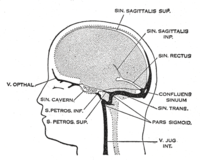
Photo from wikipedia
Background Headache is the most frequent symptom of cerebral venous thrombosis (CVT) but there is limited information about the frequency and phenotype of headache, weeks to months after cerebral venous… Click to show full abstract
Background Headache is the most frequent symptom of cerebral venous thrombosis (CVT) but there is limited information about the frequency and phenotype of headache, weeks to months after cerebral venous thrombosis (post-cerebral venous thrombosis headache, PCH). Objective To assess the frequency, characteristics and predictors of PCH. Methods In this cross-sectional study, the frequency and characteristics of PCH were assessed in cerebral venous thrombosis survivors. Patients were interviewed between six months and five years after the cerebral venous thrombosis diagnosis. Clinical and imaging characteristics at the time of cerebral venous thrombosis diagnosis, as well as history of headache prior to cerebral venous thrombosis were compared in subjects with (GroupPCH) and without PCH (Groupcontrol). Results Subjects (n = 100; 82% women) were assessed, on average, at 1.1 ± 1.6 years of follow-up. PCH was present in 59% of the patients, phenotypes of tension-type-like headache were present in 31/59 (52.6%) and of migraine-like headache in 16/59 (27.1%). History of primary headache prior to cerebral venous thrombosis was significantly more common (OR: 6.4; 95% CI: 1.7–36.3) in GroupPCH (33.9%) than in Groupcontrol (7.3%). Conclusion PCH was present in more than half of the patients. History of prior headache may be a risk factor for PCH. Prospective studies are required to confirm these findings and determine mechanisms, as well as interventions for prevention and treatment of PCH.
Journal Title: Cephalalgia
Year Published: 2022
Link to full text (if available)
Share on Social Media: Sign Up to like & get
recommendations!